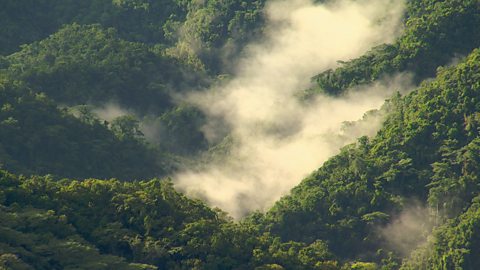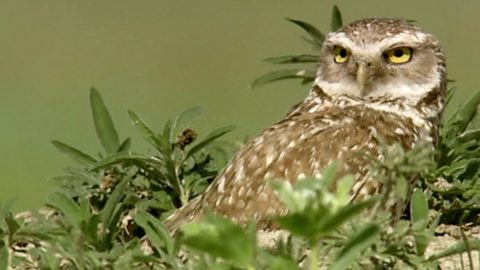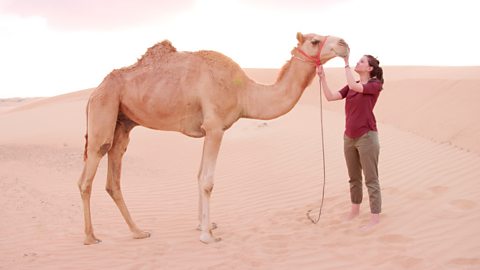Exploring how animals, plants and people have adapted to live in the Alpine mountain region.
The video
Woah! Check out that view! What a picture-perfect destination! But aside from being a popular ski resort with 80 runs, what else flourishes here in The Alps?
I’m here in La Thuille, in the Aosta Valley, in Italy.
Other similar mountainous areas like these around the world include The Rockies and Appalachian Mountains in North America and The Alps and Pyrenees here in Europe.
As you can see by what I’m wearing it’s pretty cold here today. The winters tend to be very cold, with heavy snowfall - which make it a perfect destination for ski holidays. The summers however are quite the opposite. The weather is hot and they have frequent storms.
These Alpine valleys have been glaciated, so typically they are very deep, with steep sides and wide, flat bases. Because of this characteristic U-shape, towns and villages can be found along the valley floor. People have adapted to the slopes of the valleys in a number of ways.
Traditional farming involves growing crops on the valley floor. In summertime, livestock would be moved up to pasture on the higher slopes, while hay would be grown on the richer soils close to the bottom of valley, ready to feed the animals during winter.
The direction a slope faces also influences land use. So, the sunnier south-facing slopes tend to have crops, settlements and vineyards; whereas the more shaded north-facing slopes tend to have trees. Altitude also effects trees and plants as conditions become colder and more challenging.
It’s starting to feel pretty cold, so how do these trees manage to survive the freezing winters?
Larch and fir trees have really thick bark to help them cope with cold conditions. Their branches are very flexible and droop downwards when covered in snow so they don’t snap - it’s pretty clever, eh? The needles of the fir trees are thin and waxy, helping to reduce water loss, and as they are evergreen they photosynthesize whenever light is available.
Pinecones help to protect the seeds during winter, ensuring that the species survive.
You’ll notice that unlike the fir trees, larches are deciduous - which which means that they lose their leaves in winter.
I’m at the side of the valley floor, but along the valley floor there are fields and mixed woodland of oak and chestnut trees. It’s winter now, but during the spring and summer the valley floor is full of fruit and vines benefiting from the lovely, warm weather.
As you go up the slopes you can see how the vegetation changes.
So, closer to the bottom, you have the mixed woodland; but as you increase you can see the more coniferous trees, like larch and fir, which can grow up to 40m high! And at the very top you get some pine trees as well. The larch really stand out, because they lose their leaves in winter.
So, this here is the treeline - the line, or altitude, above which no tree can grow.
Above this you find small plants and shrubs like Alpine rose and bilberry. These grow really close to the ground to protect themselves from strong, cold winds. And their leaves are thick and waxy to help retain moisture. In the grasses above 2400m, you can also find arnica, which I hear is pretty good for bruises!
On the subject of survival… Meet the ibex - a wild goat, adapted to living in the mountains of Europe. In winter they have thick warm woolly coats to help keep them warm; in summer they moult to help keep cool.
Ibex have very strong legs and specially-adapted feet for moving up and down the steep slopes!
On a smaller scale, this is the Alpine marmot. These little rodents can be found across mountain ranges in Europe.
In the summer months they feed on herbs, grasses, flowers and other plants to build up vital fat reserves in order to survive the lean winter months. They survive throughout winter by hibernating between the months of October and April, so they are busy having a snooze right now!
So, as you can see, lots of things have had to adapt in order to survive the weather conditions here - including us humans, who have adapted to the environment through tourism.
And, on that note, where are my skis? Ah, and you’d better bring some arnica too, because I am definitely going to have some bruises!
Video summary
Download/print a transcript of the video.
Wildlife presenter Ferne Corrigan explores the Alpine mountains around La Thuile in Italy to see how people, plants and animals have adapted to live here.
Ferne starts by locating the alpine mountain ranges around the world before describing the climate and landscape.
She explains traditional alpine farming and land use in the valleys as well as the adaptations of trees and plants, before describing how the ibex and alpine marmot have adapted to the conditions.
This clip is from the series Ecosystems and Biomes.
Teacher Notes
Key Stage 3
This could be used to introduce students to the alpine biomes, and how different species have adapted to these extreme conditions.
Students could create fact-files on how plants, animals and people have adapted to thrive in this biome.
Students could take a more in-depth look at the farming techniques developed by people living in the valleys to make the most of the conditions available.
Key Stage 4
This could be used to refresh students knowledge of the alpine biomes, and how different species have adapted to these extreme conditions.
Students could create fact-files on how plants, animals and people have adapted to thrive in this biome.
Students could take a more in-depth look at the farming techniques developed by people living in the valleys to make the most of the conditions available.
This clip will be relevant for teaching Geography at KS3 and GCSE.
This topic appears in OCR, Edexcel, AQA, WJEC KS4/GCSE in England, CCEA GCSE in Northern Ireland, Progression Step 4/5/GCSE in Wales, and SQA National 4/5 in Scotland.
The wildlife and ecosystem of tropical rainforests. video
Exploring the plants and animals living in the different layers of the tropical rainforest biome.

The wildlife and ecosystem of temperate savannas. video
Exploring grasslands to discover how plants, animals and people have adapted to the temperate savanna biome.

How animals and people adapt to live in the Arabian Desert. video
How people, plants and animals have adapted to survive the harsh conditions of the Arabian Desert.
